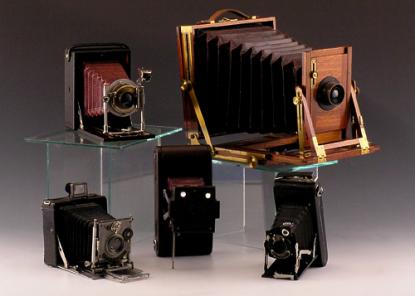2025. April 26. Saturday
Black House - Szeged
|
|
Address: 6720, Szeged Somogyi utca 13.
Phone number: (62) 425-033
E-mail: info@mfm.u-szeged.hu
Opening hours: Mon-Wed 10-18, Thu 10-20, Fri-Sun 10-18
|
The exhibition has closed for visitors.
2006.02.24. - 2006.06.11.
Museum tickets, service costs:
|
Ticket for adults
|
1290 HUF
|
|
|
Ticket for students
|
690 HUF
|
|
|
Ticket for pensioners
(under 65 years of age)
|
690 HUF
|
|
|
Ticket for families
(2 adults + 3 children)
|
2990 HUF
|
/ family
|
|
Guide
|
5000 HUF
|
More than two hundred cameras important from the point of view of the history of technique are shown at the exhibition of the Móra Ferenc Museum titled 'From the Hole Cameras to the Duflex'. This is the first exhibition since the building was renovated.

The organizers divided the development of the technique of photography into three units. In the first one, they show the period from the middle of the 19th century until 1890. The camera designed by Jedlik Ányos is for example in this ward.
The next period is until the middle of the 20th century when amateur forms of photography were very popular. Those with metal frame drove out the cameras with wooden frame and the objectives of the new cameras gave increasingly clearer pictures.
The third period is from 1926 until the 1960's. Photography became part of the everydays in this period. 1960 is a boundary in the history of photography as the Japan made cameras appeared that time.
A studio with the atmosphere of the turn of the century is also built up in the ward. One of the most interesting of the cameras is a fake. The German made Leica was very popular in the social regime, since it could not be bought in Hungary. Sometimes Russian cameras were rebuilt so they looked like a real Leica. According to professionals, a fake like this can be more valuable than an original one.

The organizers divided the development of the technique of photography into three units. In the first one, they show the period from the middle of the 19th century until 1890. The camera designed by Jedlik Ányos is for example in this ward.
The next period is until the middle of the 20th century when amateur forms of photography were very popular. Those with metal frame drove out the cameras with wooden frame and the objectives of the new cameras gave increasingly clearer pictures.
The third period is from 1926 until the 1960's. Photography became part of the everydays in this period. 1960 is a boundary in the history of photography as the Japan made cameras appeared that time.
A studio with the atmosphere of the turn of the century is also built up in the ward. One of the most interesting of the cameras is a fake. The German made Leica was very popular in the social regime, since it could not be bought in Hungary. Sometimes Russian cameras were rebuilt so they looked like a real Leica. According to professionals, a fake like this can be more valuable than an original one.
